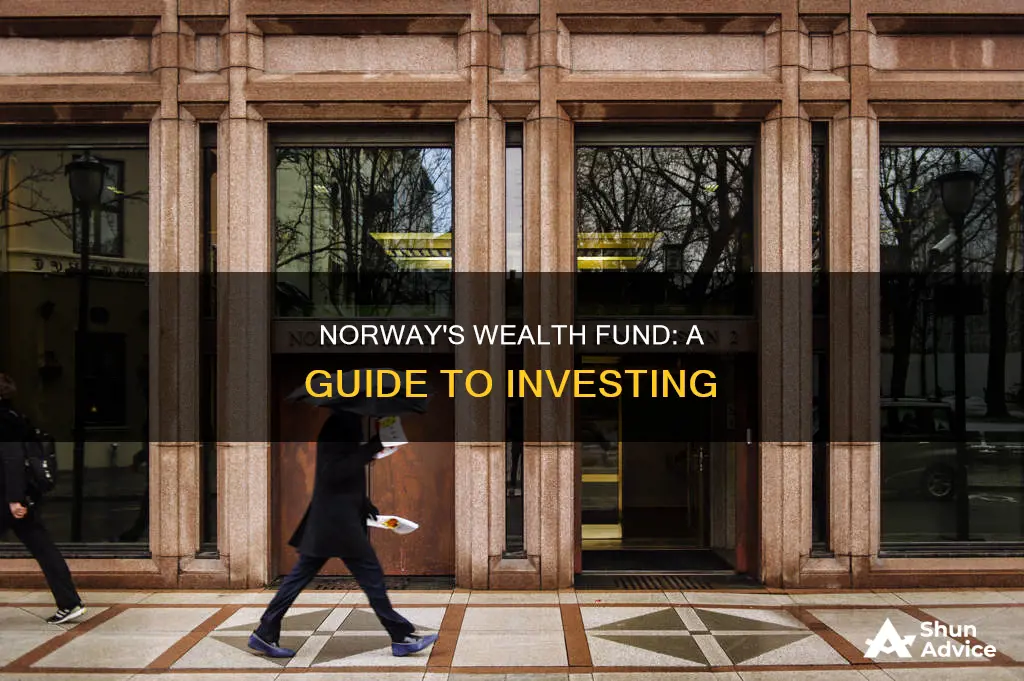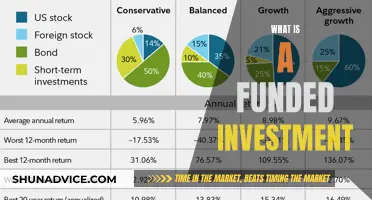
Norway's sovereign wealth fund, also known as the Government Pension Fund Global, is the world's largest single sovereign wealth fund in terms of total assets under management. Established in 1990, the fund is worth over $1 trillion and holds shares, bonds, and real estate globally. The fund's primary objective is to support the long-term management of government spending on oil reserves, protecting the Norwegian economy and maintaining the value of oil assets for future generations. With a focus on ethical and sustainable investing, the fund has been successful in managing large oil and gas revenues responsibly, contributing to Norway's economic stability and high standard of living.
| Characteristics | Values |
|---|---|
| Name | Government Pension Fund Global (GPFG) |
| Owner | Government of Norway |
| Managed by | Norges Bank Investment Management (NBIM), part of the Norwegian Central Bank |
| Established | 1990 |
| Purpose | Invest surplus revenues of the Norwegian petroleum sector |
| Fund size | Over US$1.71 trillion in assets as of August 2024 |
| Investments | Equities, bonds, real estate, renewable energy infrastructure |
| Equity investments | Spread across 9,000 companies |
| Equity allocation | ~70% of the fund |
| Fixed-income investments | Bonds, securities issued by companies |
| Fixed-income allocation | ~30% of the fund |
| Real estate allocation | Up to 7% of the fund |
| Renewable energy infrastructure allocation | Up to 2% of the fund |
What You'll Learn

Invest in stocks, bonds and property
The Government Pension Fund of Norway is the sovereign wealth fund collectively owned by the government of Norway. It consists of two entirely separate sovereign wealth funds: the Government Pension Fund Global and the Government Pension Fund Norway.
The Government Pension Fund Global, also known as the Oil Fund, was established in 1990 to invest the surplus revenues of the Norwegian petroleum sector. As of August 2024, it had over US$1.71 trillion in assets, making it the world's largest single sovereign wealth fund. The fund is invested in over 9,000 companies across 73 countries, with about 70% of the fund invested in equities, and about 30% in fixed income. The fund's investments are spread across stocks, bonds, and property.
The equity investments are spread across 9,000 companies to capture global value creation and diversify risk. The fund holds shares in companies across the world, but only invests abroad so that the Norwegian economy does not overheat. The fund's equity investments are diverse, with holdings in companies across various sectors and countries.
The fixed-income investments are allocated to bonds issued by governments and related institutions, as well as securities issued by companies. The fund holds foreign government and corporate bonds. Up to 7% of the fund can be invested in unlisted real estate, with a focus on high-quality properties in major cities and global distribution networks.
The Government Pension Fund Norway, established in 1967, is the smaller of the two funds and is managed separately from the Oil Fund. It is limited to domestic and Nordic investments and is a key stockholder in many large Norwegian companies, predominantly via the Oslo Stock Exchange.
Both funds are managed by Norges Bank Investment Management (NBIM), part of the Norwegian Central Bank, on behalf of the Ministry of Finance. The Ministry decides the overall investment strategy for the funds, with the NBIM's Executive Board issuing a strategic plan for management, including the main investment strategies to be employed.
Smart Mutual Fund Investing with 1 Lakh
You may want to see also

Think long-term
Thinking long-term is a key principle of Norway's sovereign wealth fund, and it is one of the reasons for its success. The fund was established in the 1990s to manage the country's oil and gas revenues sustainably and create wealth for future generations. This long-term perspective is reflected in the fund's investment strategy, which aims to maximise financial returns over time while minimising risk.
The fund's long-term horizon allows it to weather short-term market fluctuations and focus on generating excess returns over relevant benchmarks. For example, during the 2008 financial crisis, the fund increased its share of equities, which contributed to a strong recovery in 2009. This ability to take a long-term view sets the fund apart from typical retail investors, who may be more prone to selling when markets decline.
The fund's long-term focus also aligns with its ethical and environmental objectives. As a responsible investor, the fund promotes sustainable development and good corporate governance. It has implemented ethical guidelines and blacklisted companies that do not meet its standards. By prioritising intergenerational equity, the fund ensures that the benefits of its investments are not limited to the present but are also enjoyed by future generations.
The success of Norway's sovereign wealth fund in generating long-term value has made it a model for other countries. Its ability to convert volatile oil assets into stable investment portfolios provides a blueprint for managing natural resource revenues sustainably. This approach has helped Norway avoid the "resource curse" and build one of the largest sovereign wealth funds in the world.
Therefore, thinking long-term is a critical aspect of Norway's sovereign wealth fund strategy. It enables the fund to balance financial returns, risk management, and ethical considerations for the benefit of both current and future generations.
Mutual Fund Dividend Reinvestment: Powering Compounding Returns
You may want to see also

Diversify your portfolio
Diversifying your portfolio is a key principle of investing in Norway's sovereign wealth fund. The fund is invested in a wide range of asset classes, including foreign direct investment, hedge funds, private equity, and more traditional investments such as stocks, bonds, and property.
The fund's equity investments are spread across 9,000 companies worldwide, capturing global value creation and diversifying risk. About 70% of the fund is invested in equities, with the remaining 30% in fixed-income investments such as bonds issued by governments and related institutions, and securities issued by companies.
The fund also invests in real estate, with a focus on high-quality properties in major cities and global distribution networks. Up to 7% of the fund can be invested in unlisted real estate.
Additionally, the fund has started to invest in renewable energy infrastructure, with a particular focus on wind and solar projects in Europe and North America. Up to 2% of the fund can be allocated to this sector.
By diversifying across countries, sectors, and currencies, the fund aims to stabilize the Norwegian economy, generate wealth for future generations, and provide cost-effective exposure to broad equity and bond markets.
Bond Funds: Risky Business, Not Worth Your Investment
You may want to see also

Invest in renewable energy infrastructure
Norway's sovereign wealth fund, the Government Pension Fund of Norway, is the world's largest single sovereign wealth fund, with over $1.71 trillion in assets as of August 2024. The fund is made up of two entirely separate entities: the Government Pension Fund Global and the Government Pension Fund Norway.
The Government Pension Fund Global, commonly known as the Oil Fund, was established in 1990 to invest the surplus revenues from the Norwegian petroleum sector. The fund's purpose is to invest parts of the large surplus generated by the Norwegian oil and gas industry, including taxes from companies, payments for licenses to explore for oil, the State's Direct Financial Interest, and dividends from the partly state-owned Equinor.
Norway's sovereign wealth fund has recently expanded its investment strategy to include renewable energy infrastructure. In 2020, the fund was allowed to start making direct investments in renewable energy projects, with a target of investing around 2% of its value in renewables infrastructure over time. This expansion into renewable energy is in line with the fund's overall investment strategy, which includes a focus on long-term investments and environmental considerations.
- Wind and Solar Projects: The fund primarily invests in wind and solar projects in Europe and North America. These projects offer stable, long-term returns and contribute to the fund's environmental goals.
- Unlisted Renewable Energy Projects: The fund can now invest in unlisted renewable energy projects, providing opportunities to support emerging or smaller-scale initiatives. These investments are made under "environment-related mandates" and are subject to profitability and transparency requirements.
- International Investments: Norway's fund invests globally outside of Norway to avoid overheating the Norwegian economy. This strategy allows the fund to diversify its portfolio and reduce the risk of investing in a single market.
- Gradual Approach: The fund's management has stated that it will adopt a gradual approach to investing in renewable energy infrastructure. This strategy allows for a careful assessment of opportunities and a better management of risk, especially in a relatively small and competitive market.
- Cost-Effectiveness: The fund aims for cost-effective investments, considering the current economic climate and market competition. By seeking opportunities where prices are not too high, the fund can maximize its returns while managing risk.
- Ethical and Environmental Considerations: Norway's fund has a strong focus on ethical and environmental considerations. It excludes companies involved in activities such as arms production, tobacco, and excessive fossil fuel use. By investing in renewable energy, the fund contributes to Norway's transition to a more environmentally sustainable economy.
By following these strategies, Norway's sovereign wealth fund aims to balance profitability and risk while contributing to the global shift towards renewable energy and sustainable economic growth.
Mirae Asset Emerging Bluechip Fund: A Smart Investment Strategy
You may want to see also

Be mindful of home biases
Norway's sovereign wealth fund has lessons for retail investors, according to Clemens Bomsdorf, author of the book "How to Become Rich Like Norway: Easy Tips on How to Build a Fortune". One of these lessons is to be mindful of home biases.
The Government Pension Fund of Norway is the sovereign wealth fund collectively owned by the government of Norway. It consists of two entirely separate sovereign wealth funds: the Government Pension Fund Global and the Government Pension Fund Norway. The former is commonly referred to as the Oil Fund and was established in 1990 to invest the surplus revenues of the Norwegian petroleum sector. The latter is smaller and was established in 1967 as a type of national insurance fund. It is managed separately from the Oil Fund and is limited to domestic and Nordic investments.
The Government Pension Fund Global is invested in international financial markets, so the risk is independent of the Norwegian economy. As of August 2024, it had over US$1.71 trillion in assets, making it the world's largest single sovereign wealth fund in terms of total assets under management. The fund is invested in over 9,000 companies across countries, sectors, and currencies.
The Government Pension Fund Norway, on the other hand, is required to limit its investments to companies in the Norwegian stock market, predominantly on the Oslo Stock Exchange. It is a key stockholder in many large Norwegian companies.
When investing in Norway's sovereign wealth fund, it is important to be mindful of home biases. This means considering the potential bias towards investing in domestic companies or markets over international ones. While the Government Pension Fund Global is invested internationally, the Government Pension Fund Norway is limited to domestic and Nordic investments. This home bias may impact the level of diversification and risk associated with the fund.
Additionally, Norway's sovereign wealth fund as a whole has been criticised for its tendency to ignore stocks from emerging markets and small caps. This could be considered a form of home bias, as it may reflect a preference for more established companies or markets.
Therefore, when investing in Norway's sovereign wealth fund, it is important to be mindful of any potential home biases that may influence the fund's investment strategy. This includes considering the balance between domestic and international investments, as well as the types of companies and markets the fund invests in. By being aware of these biases, investors can make more informed decisions about their investments.
Vanguard Funds: Best UK Investment Options
You may want to see also
Frequently asked questions
Norway's sovereign wealth fund is a state-owned pool of money that is invested in various financial assets. It was set up to invest the surplus revenues of the country's oil and gas sector.
The fund invests in various financial assets, including stocks, bonds, property, and renewable energy infrastructure. It is managed by Norges Bank Investment Management (NBIM), part of the Norwegian Central Bank, on behalf of the Ministry of Finance. The Ministry decides on the overall investment strategy and ethical guidelines, while NBIM covers the day-to-day portfolio operations.
The fund has delivered strong returns over the years, with its highest ever return in kroner in 2023, at 16.1%. However, it also experienced a record loss in 2022, attributed to "very unusual" market conditions.







